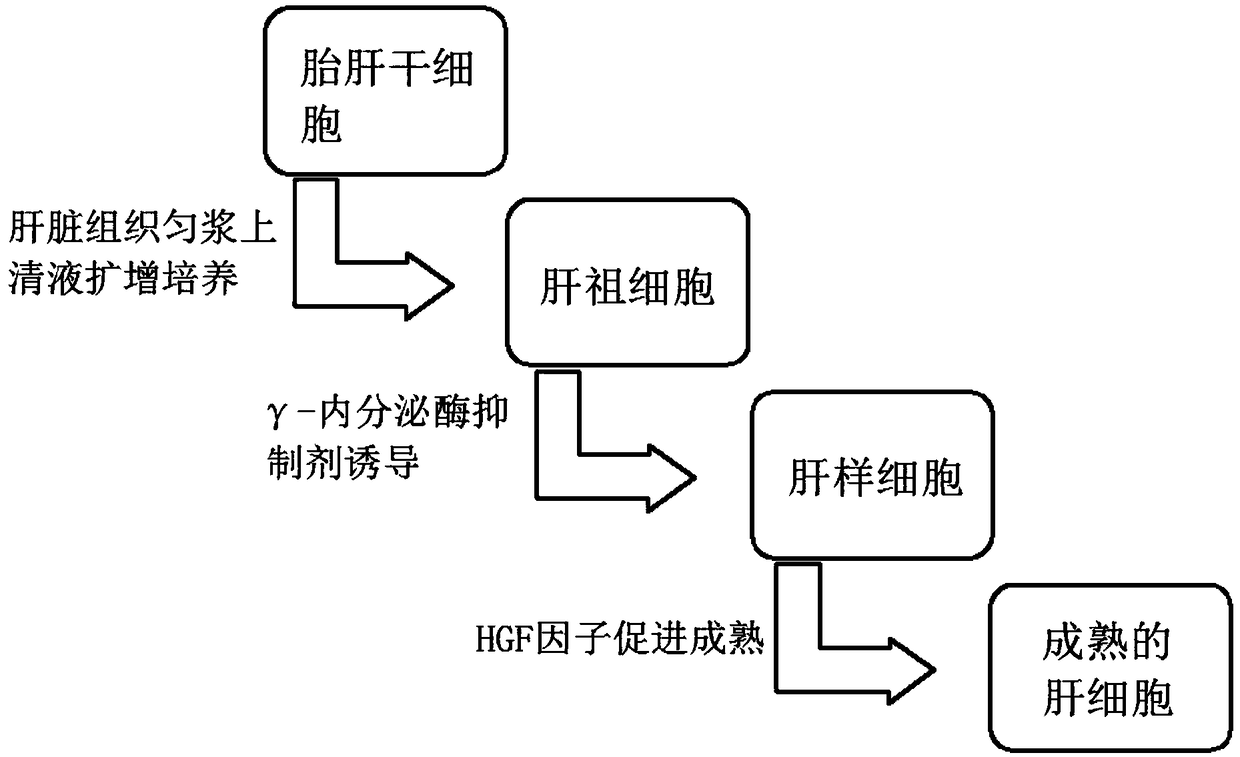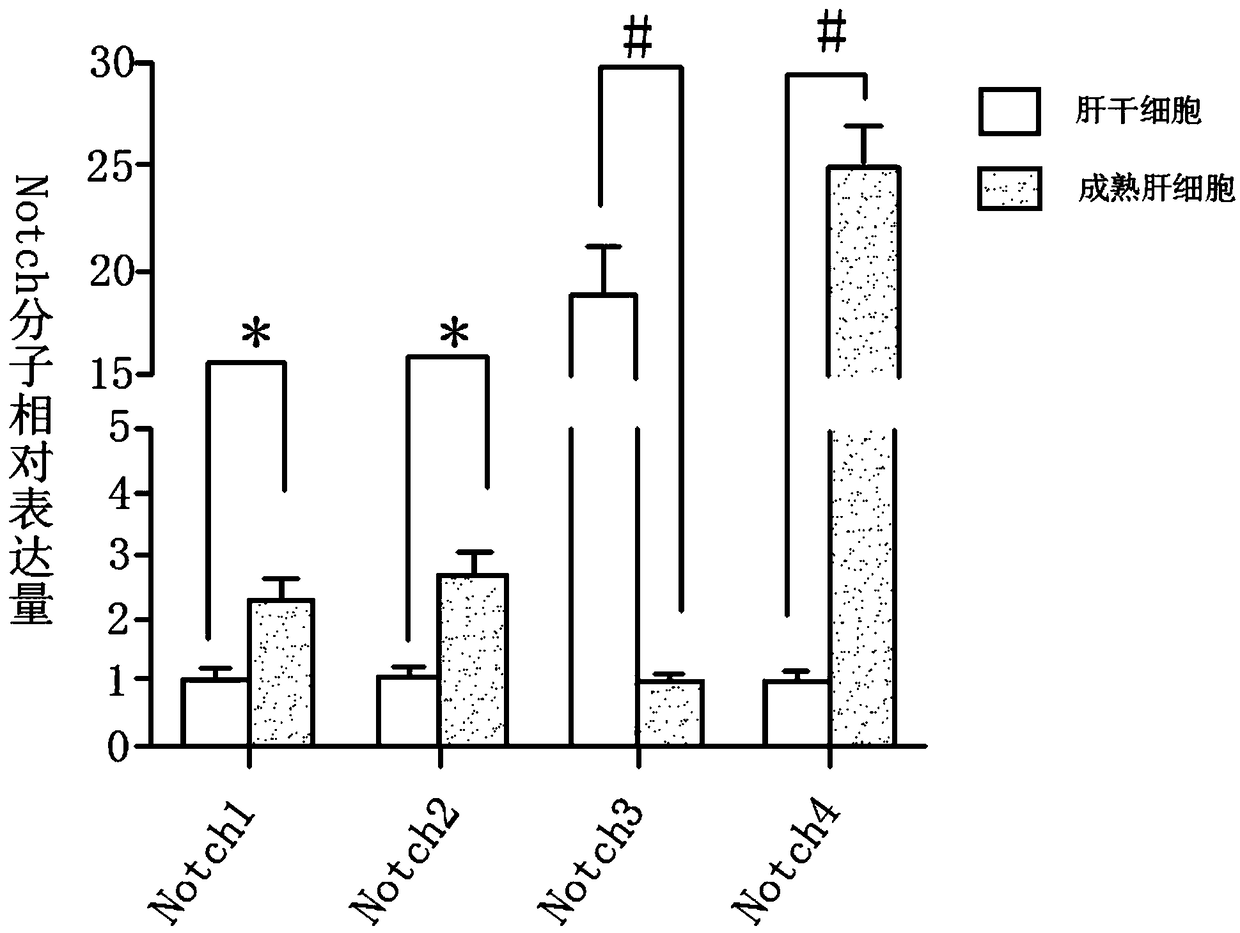Method for inducing fetal hepatic stem cells to differentiate into mature hepatic cells in three-step sequential mode
A technology for inducing differentiation and stem cells, applied in the biological field, can solve the problems of low model efficiency and poor accuracy, achieve the effect of inhibiting the activity of transaminases and restoring the level of liver albumin
- Summary
- Abstract
- Description
- Claims
- Application Information
AI Technical Summary
Problems solved by technology
Method used
Image
Examples
Embodiment 1
[0046] like figure 1 As shown, the present invention provides a three-step sequential method for inducing fetal liver stem cells to differentiate into mature hepatocytes, comprising the following steps:
[0047] (1) Obtaining and identification of fetal liver stem cells:
[0048] 1) Isolation, cultivation and expansion of fetal liver stem cells mainly include the following steps: a. Using Percoll discontinuous density gradient centrifugation to enrich rat fetal liver cells; b. Using jet lag attachment and jet lag digestion to culture fetal liver cells Purification; c, using Percoll continuous density gradient centrifugation to enrich rat fetal liver stem cells.
[0049] 2) Identification of fetal liver stem cells: the stem cells were identified by immunohistochemistry and immunofluorescence multiple antibody staining, wherein the stem cell marker used was CD133.
[0050] (2) Induced differentiation of fetal liver stem cells:
[0051] a) Collect normal liver tissue at low te...
Embodiment 2
[0057] like figure 1 As shown, the present invention provides a three-step sequential method for inducing fetal liver stem cells to differentiate into mature hepatocytes, comprising the following steps:
[0058] (1) Obtaining and identification of fetal liver stem cells:
[0059] 1) Separation, culture and expansion of fetal liver stem cells mainly include the following steps: a. Using Percoll discontinuous density gradient centrifugation to enrich rat fetal liver cells; b. Using jet lag attachment and jet lag digestion to culture fetal liver cells performing purification; c, using Percoll continuous density gradient centrifugation to enrich rat fetal liver stem cells.
[0060] 2) Identification of fetal liver stem cells: the stem cells were identified by immunohistochemistry and immunofluorescence multiple antibody staining, wherein the stem cell marker used was EpCAM.
[0061] (2) Induced differentiation of fetal liver stem cells:
[0062] a) Collect normal liver tissue a...
Embodiment 3
[0068] like figure 1 As shown, the present invention provides a three-step sequential method for inducing fetal liver stem cells to differentiate into mature hepatocytes, comprising the following steps:
[0069] (1) Obtaining and identification of fetal liver stem cells:
[0070] 1) Separation, culture and expansion of fetal liver stem cells mainly include the following steps: a. Using Percoll discontinuous density gradient centrifugation to enrich rat fetal liver cells; b. Using jet lag attachment and jet lag digestion to culture fetal liver cells performing purification; c, using Percoll continuous density gradient centrifugation to enrich rat fetal liver stem cells.
[0071] 2) Identification of fetal liver stem cells: the stem cells were identified by immunohistochemistry and immunofluorescence multiple antibody staining, wherein the stem cell marker used was CD49f.
[0072] (2) Induced differentiation of fetal liver stem cells:
[0073] a) Collect normal liver tissue a...
PUM
 Login to View More
Login to View More Abstract
Description
Claims
Application Information
 Login to View More
Login to View More - R&D
- Intellectual Property
- Life Sciences
- Materials
- Tech Scout
- Unparalleled Data Quality
- Higher Quality Content
- 60% Fewer Hallucinations
Browse by: Latest US Patents, China's latest patents, Technical Efficacy Thesaurus, Application Domain, Technology Topic, Popular Technical Reports.
© 2025 PatSnap. All rights reserved.Legal|Privacy policy|Modern Slavery Act Transparency Statement|Sitemap|About US| Contact US: help@patsnap.com



